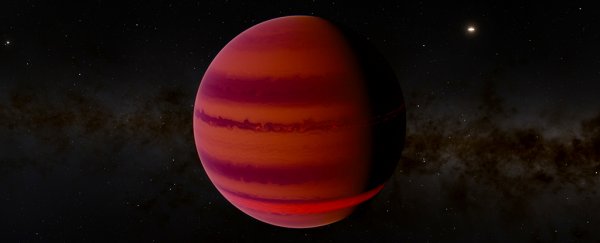Astronomers have estimated that the Milky Way could contain roughly one brown dwarf for every two other stars, potentially tripling a previous estimate that left us wondering where they were all hiding.
The new research was based on a star cluster outside of our Solar System's immediate neighbourhood, suggesting our corner of the galaxy isn't exactly typical as far as star production goes.
Back in 2012, observations made by NASA's Wide-field Infrared Survey Explorer (WISE) on nearby star clusters indicated only one in seven stars was a brown dwarf, fewer than the 1:1 ratio astronomers had expected.
The odd results were considered preliminary, and now by turning their gaze a little further from home an international team of astronomers have found much to their relief our galaxy has far more of these dark suns than first appeared.
Brown dwarfs are somewhere between a planet and a main sequence star, in that they're massive objects that just fall short of squeezing its matter enough to spark a fusion reaction.
That makes them of particular interest to astrophysicists who want to know how stars are born.
Such "failed stars" don't shine brightly like their bigger, more successful siblings, but they can reach masses in the order of 90 times the mass of Jupiter, or about 10 percent the mass of our Sun.
Being kind of dull makes them hard to spot, limiting brown dwarf hunting to star clusters less than 1500 light years away – just over the Solar System's back fence in a galaxy 100,000 light years across.
After stumbling across a cluster containing an unexpected number of brown dwarfs, the researchers used the European Southern Observatory's Very Large Telescope in northern Chile to analyse the stars in a far off cluster called RCW38, a young bunch of stars 1.7 kiloparsecs (just over 5500 light years) away.
Its density and richness in massive stars made it an ideal place to look at the formation of brown dwarfs in such an environment and test whether the previous finds were anomalies.
It turns out astronomers were pretty much on the money about how common failed stars are.
"We've found a lot of brown dwarfs in these clusters. And whatever the cluster type, the brown dwarfs are really common. Brown dwarfs form alongside stars in clusters, so our work suggests there are a huge number of brown dwarfs out there," says Aleks Scholz from the University of St. Andrews in Scotland.
Fortunately the stars are hot enough to emit a faint glow in infra-red, so while they don't stand out in the brilliance of other nearby stars, they can be seen.
To actually detect the faint bodies of brown dwarfs in the cluster, the astronomers used technology that accounted for distortions in the Earth's atmosphere in conjunction with a high resolution infra-red camera and spectrometer.
Based on their counts, there could be anywhere between 25 and 100 billion brown dwarf stars in the Milky Way, with one failed star for every 2 to 5 main sequence star.
That puts the clusters near our Solar System at the lower end of the spectrum.
Since brown dwarfs are so hard to spot, the researchers are intentionally being conservative with their estimates, so it's likely that for every star sparkling in the galaxy, there's another one that just wasn't big enough to shine.
"They are ubiquitous denizens of our Milky Way galaxy," says Ray Jayawardhana from York University in Canada.
With the recent discovery of nearly all stars being born with at least a twin, it's possible that there is a lot of celestial sibling rivalry going on over our heads.
The research is currently available on the pre-review website arXiv.org, and will be presented at this year's National Astronomy Meeting in the UK.
